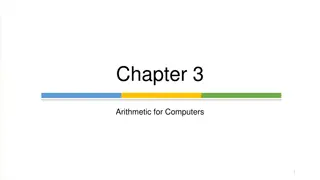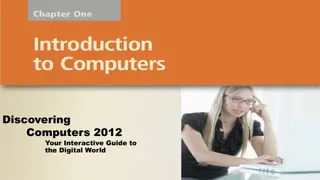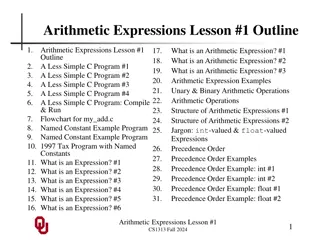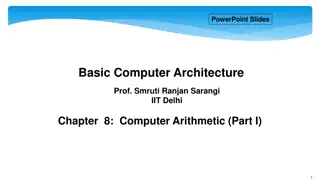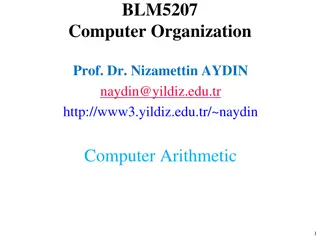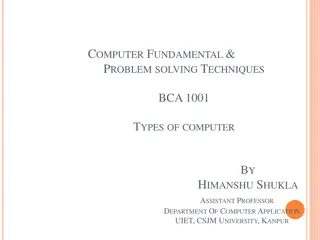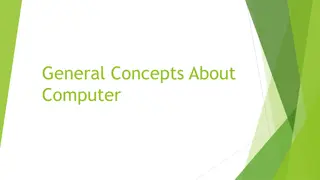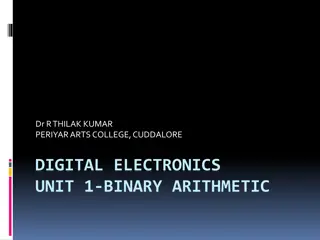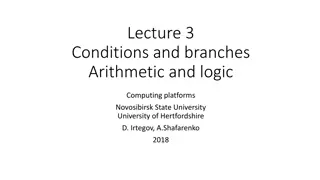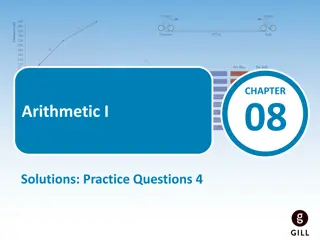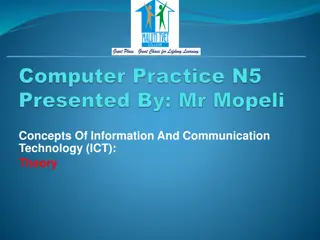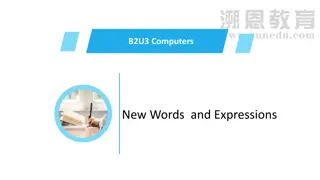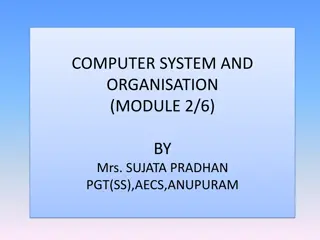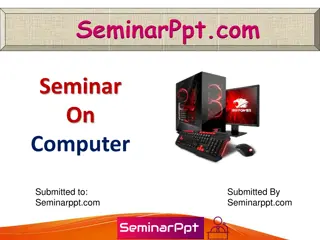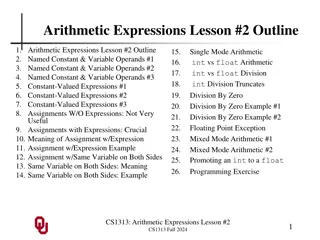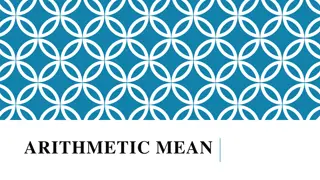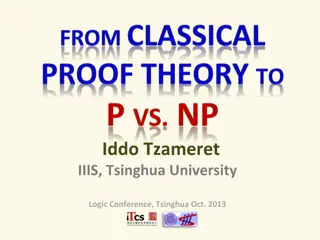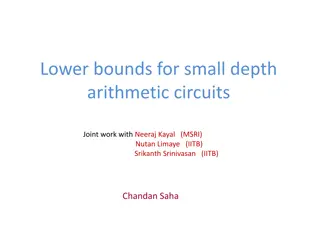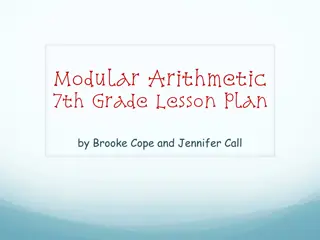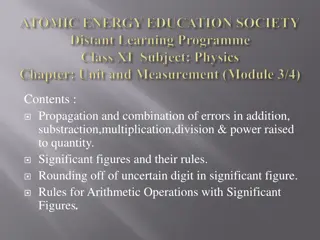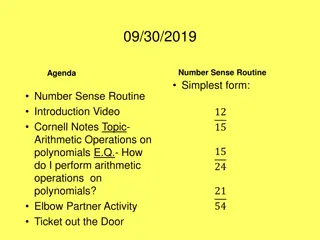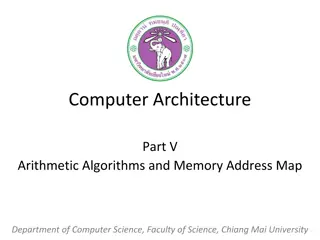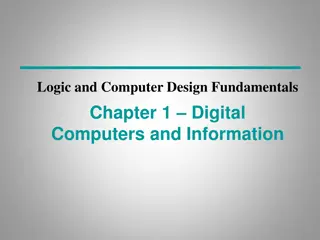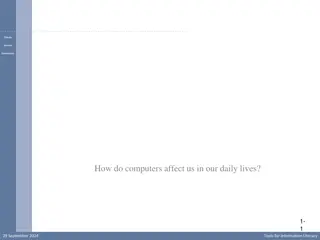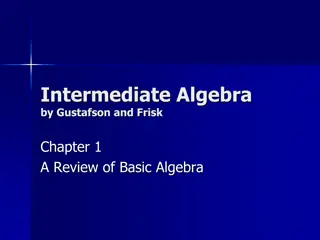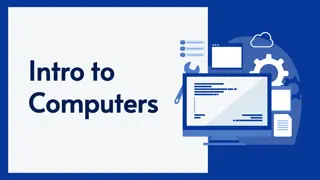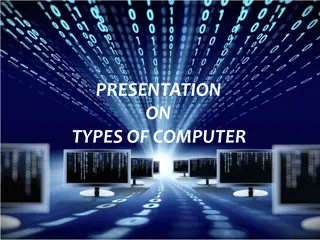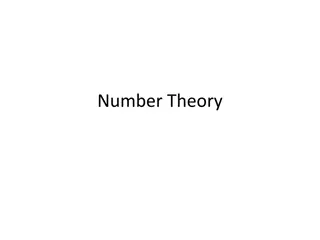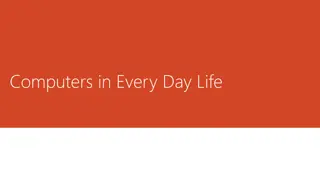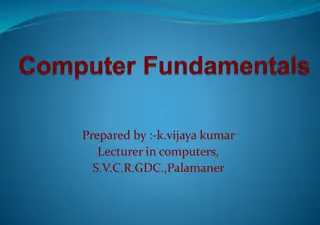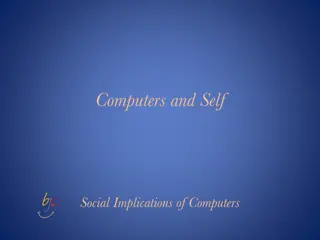Understanding Arithmetic Operations for Computers
Explore fundamental arithmetic operations for computers, including addition, subtraction, multiplication, and division. Learn about dealing with overflow, real numbers in floating-point representation, and strategies for optimizing arithmetic efficiency. Discover why carry propagation can be slow and how lookahead techniques can enhance computational speed.
Download Presentation

Please find below an Image/Link to download the presentation.
The content on the website is provided AS IS for your information and personal use only. It may not be sold, licensed, or shared on other websites without obtaining consent from the author. Download presentation by click this link. If you encounter any issues during the download, it is possible that the publisher has removed the file from their server.
E N D
Presentation Transcript
NSWI178 - lecture 2 Arithmetic for Computers Original slides from: https://www.slideshare.net/ececourse/chapter-3-3372943
3.1 Introduction Arithmetic for Computers Operations on integers Addition and subtraction Multiplication and division Dealing with overflow Floating-point real numbers Representation and operations Chapter 3 Arithmetic for Computers 2
3.2 Addition and Subtraction Integer Addition Example: 7 + 6 Overflow if result out of range Adding +ve and ve operands, no overflow Adding two +ve operands Overflow if result sign is 1 Adding two ve operands Overflow if result sign is 0 Faster variant: book page 1197 Chapter 3 Arithmetic for Computers 3
3.2 Addition and Subtraction Integer Addition Chapter 3 Arithmetic for Computers 4
3.2 Addition and Subtraction Integer Addition One-bit variant: Faster variant: book page 1197 Chapter 3 Arithmetic for Computers 5
Integer Subtraction Add negation of second operand Example: 7 6 = 7 + ( 6) +7: 6: +1: 0000 0000 0000 0001 Overflow if result out of range Subtracting two +ve or two ve operands, no overflow Subtracting +ve from ve operand 0000 0000 0000 0111 1111 1111 1111 1010 Overflow if result sign is 0 Subtracting ve from +ve operand Overflow if result sign is 1 Chapter 3 Arithmetic for Computers 6
Why is all this too slow? Carry-in bit takes long time to set (propagation delay) In the worst case propagates all the way from least significant bits Depth is the enemy => lets do it wide What if we look ahead whether there will be a carry-in? Generate or Propagate carry (A and B) will generate, (A or B) will propagate Can be determined for several bits ahead, and sent forward quickly Chapter 3 Arithmetic for Computers 7
Why is all this too slow? Carry lookahead Can be determined for several bits ahead, and sent forward quickly C4 only needs to get through one AND gate to get C8 -> quite fast Can be done hierarchically Chapter 3 Arithmetic for Computers 8
Arithmetic for Multimedia Graphics and media processing operates on vectors of 8-bit and 16-bit data Use 64-bit adder, with partitioned carry chain Operate on 8 8-bit, 4 16-bit, or 2 32-bit vectors SIMD (single-instruction, multiple-data) Saturating operations On overflow, result is largest representable value c.f. 2s-complement modulo arithmetic E.g., clipping in audio, saturation in video Chapter 3 Arithmetic for Computers 9
3.3 Multiplication Multiplication Start with long-multiplication approach multiplicand 1000 multiplier 100 1 1000 0000 0000 1000 1001000 product Length of product is the sum of operand lengths Chapter 3 Arithmetic for Computers 10
Multiplication Hardware Initially 0 Chapter 3 Arithmetic for Computers 11
Faster Multiplier Uses multiple adders Cost/performance tradeoff Can be pipelined Several multiplication performed in parallel Chapter 3 Arithmetic for Computers 12
Division Hardware Initially divisor in left half Initially dividend Chapter 3 Arithmetic for Computers 13
3.5 Floating Point Floating Point Representation for non-integral numbers Including very small and very large numbers Like scientific notation 2.34 1056 +0.002 10 4 +987.02 109 In binary 1.xxxxxxx2 2yyyy Types floatand doublein C normalized not normalized Chapter 3 Arithmetic for Computers 14
Floating Point Standard Defined by IEEE Std 754-1985 Developed in response to divergence of representations Portability issues for scientific code Now almost universally adopted Two representations Single precision (32-bit) Double precision (64-bit) Chapter 3 Arithmetic for Computers 15
IEEE Floating-Point Format single: 8 bits double: 11 bits single: 23 bits double: 52 bits S Exponent Fraction x = ( 1)S (1+Fraction) 2(Exponent Bias) S: sign bit (0 non-negative, 1 negative) Normalize significand: 1.0 |significand| < 2.0 Always has a leading pre-binary-point 1 bit, so no need to represent it explicitly (hidden bit) Significand is Fraction with the 1. restored Exponent: excess representation: actual exponent + Bias Ensures exponent is unsigned Single: Bias = 127; Double: Bias = 1203 Chapter 3 Arithmetic for Computers 16
Single-Precision Range Exponents 00000000 and 11111111 reserved Smallest value Exponent: 00000001 actual exponent = 1 127 = 126 (biased repr.) Fraction: 000 00 significand = 1.0 1.0 2 126 1.2 10 38 Largest value exponent: 11111110 actual exponent = 254 127 = +127 Fraction: 111 11 significand 2.0 2.0 2+127 3.4 10+38 Chapter 3 Arithmetic for Computers 17
Double-Precision Range Exponents 0000 00 and 1111 11 reserved Smallest value Exponent: 00000000001 actual exponent = 1 1023 = 1022 Fraction: 000 00 significand = 1.0 1.0 2 1022 2.2 10 308 Largest value Exponent: 11111111110 actual exponent = 2046 1023 = +1023 Fraction: 111 11 significand 2.0 2.0 2+1023 1.8 10+308 Chapter 3 Arithmetic for Computers 18
Floating-Point Precision Relative precision all fraction bits are significant Single: approx 2 23 Equivalent to 23 log102 23 0.3 6 decimal digits of precision Double: approx 2 52 Equivalent to 52 log102 52 0.3 16 decimal digits of precision Chapter 3 Arithmetic for Computers 19
Floating-Point Example Represent 0.75 0.75 = ( 1)1 1.12 2 1 S = 1 Fraction = 1000 002 Exponent = 1 + Bias Single: 1 + 127 = 126 = 011111102 Double: 1 + 1023 = 1022 = 011111111102 Single: 1011111101000 00 Double: 1011111111101000 00 Chapter 3 Arithmetic for Computers 20
Floating-Point Example What number is represented by the single- precision float 11000000101000 00 S = 1 Fraction = 01000 002 Exponent = 100000012 = 129 x = ( 1)1 (1 + .012) 2(129 127) = ( 1) 1.25 22 = 5.0 Chapter 3 Arithmetic for Computers 21
Denormal Numbers Exponent = 000...0 hidden bit is 0 x =( 1)S (0+Fraction) 2 Bias Smaller than normal numbers allow for gradual underflow, with diminishing precision Denormal with fraction = 000...0 x =( 1)S (0+0) 2 Bias= 0.0 Two representations of 0.0! Chapter 3 Arithmetic for Computers 22
Infinities and NaNs Exponent = 111...1, Fraction = 000...0 Infinity Can be used in subsequent calculations, avoiding need for overflow check Exponent = 111...1, Fraction 000...0 Not-a-Number (NaN) Indicates illegal or undefined result e.g., 0.0 / 0.0 Can be used in subsequent calculations Chapter 3 Arithmetic for Computers 23
Floating-Point Addition Consider a 4-digit decimal example 9.999 101 + 1.610 10 1 1. Align decimal points Shift number with smaller exponent 9.999 101 + 0.016 101 2. Add significands 9.999 101 + 0.016 101 = 10.015 101 3. Normalize result & check for over/underflow 1.0015 102 4. Round and renormalize if necessary 1.002 102 Chapter 3 Arithmetic for Computers 24
Floating-Point Addition Now consider a 4-digit binary example 1.0002 2 1 + 1.1102 2 2 (0.5 + 0.4375) 1. Align binary points Shift number with smaller exponent 1.0002 2 1 + 0.1112 2 1 2. Add significands 1.0002 2 1 + 0.1112 2 1= 0.0012 2 1 3. Normalize result & check for over/underflow 1.0002 2 4, with no over/underflow 4. Round and renormalize if necessary 1.0002 2 4(no change) = 0.0625 Chapter 3 Arithmetic for Computers 25
FP Adder Hardware Much more complex than integer adder Doing it in one clock cycle would take too long Much longer than integer operations Slower clock would penalize all instructions FP adder usually takes several cycles Can be pipelined Chapter 3 Arithmetic for Computers 26
FP Adder Hardware Step 1 Step 2 Step 3 Step 4 Chapter 3 Arithmetic for Computers 27
Floating-Point Multiplication Consider a 4-digit decimal example 1.110 1010 9.200 10 5 1. Add exponents For biased exponents, subtract bias from sum New exponent = 10 + 5 = 5 2. Multiply significands 1.110 9.200 = 10.212 10.212 105 3. Normalize result & check for over/underflow 1.0212 106 4. Round and renormalize if necessary 1.021 106 5. Determine sign of result from signs of operands +1.021 106 Chapter 3 Arithmetic for Computers 28
Floating-Point Multiplication Now consider a 4-digit binary example 1.0002 2 1 1.1102 2 2 (0.5 0.4375) 1. Add exponents Unbiased: 1 + 2 = 3 Biased: ( 1 + 127) + ( 2 + 127) = 3 + 254 127 = 3 + 127 2. Multiply significands 1.0002 1.1102= 1.1102 1.1102 2 3 3. Normalize result & check for over/underflow 1.1102 2 3 (no change) with noover/underflow 4. Round and renormalize if necessary 1.1102 2 3 (nochange) 5. Determine sign: +ve ve ve 1.1102 2 3= 0.21875 Chapter 3 Arithmetic for Computers 29
FP Arithmetic Hardware FP multiplier is of similar complexity to FP adder But uses a multiplier for significands instead of an adder FP arithmetic hardware usually does Addition, subtraction, multiplication, division, reciprocal, square-root FP integer conversion Operations usually takes several cycles Can be pipelined Chapter 3 Arithmetic for Computers 30
FP Instructions in MIPS FP hardware is coprocessor 1 Adjunct processor that extends the ISA Separate FP registers 32 single-precision: $f0, $f1, $f31 Paired for double-precision: $f0/$f1, $f2/$f3, Release 2 of MIPs ISA supports 32 64-bit FP reg s FP instructions operate only on FP registers Programs generally don t do integer ops on FP data, or vice versa More registers with minimal code-size impact FP load and store instructions lwc1, ldc1, swc1, sdc1 e.g., ldc1 $f8, 32($sp) Chapter 3 Arithmetic for Computers 31
FP Instructions in MIPS Single-precision arithmetic add.s, sub.s, mul.s, div.s e.g., add.s $f0, $f1, $f6 Double-precision arithmetic add.d, sub.d, mul.d, div.d e.g., mul.d $f4, $f4, $f6 Single- and double-precision comparison c.xx.s, c.xx.d(xx is eq, lt, le, ) Sets or clears FP condition-code bit e.g. c.lt.s $f3, $f4 Branch on FP condition code true or false bc1t, bc1f e.g., bc1t TargetLabel Chapter 3 Arithmetic for Computers 32
Interpretation of Data The BIG Picture Bits have no inherent meaning Interpretation depends on the instructions applied Computer representations of numbers Finite range and precision Need to account for this in programs (a+b)+c = a+(b+c) Chapter 3 Arithmetic for Computers 33
3.6 Parallelism and Computer Arithmetic: Associativity Associativity Parallel programs may interleave operations in unexpected orders Assumptions of associativity may fail (x+y)+z x+(y+z) -1.50E+38 x -1.50E+38 y 1.50E+38 z 0.00E+00 1.0 1.0 1.50E+38 1.00E+00 0.00E+00 Need to validate parallel programs under varying degrees of parallelism Chapter 3 Arithmetic for Computers 34
Streaming SIMD Extension 2 (SSE2) Adds 4 128-bit registers Extended to 8 registers in AMD64/EM64T Can be used for multiple FP operands 2 64-bit double precision 4 32-bit double precision Instructions operate on them simultaneously Single-Instruction Multiple-Data Chapter 3 Arithmetic for Computers 35
3.8 Fallacies and Pitfalls Right Shift and Division Left shift by i places multiplies an integer by 2i Right shift divides by 2i? Only for unsigned integers For signed integers Arithmetic right shift: replicate the sign bit e.g., 5 / 4 111110112 >> 2 = 111111102 = 2 Rounds toward c.f. 111110112 >>> 2 = 001111102 =+62 Chapter 3 Arithmetic for Computers 36




